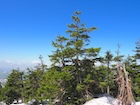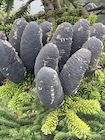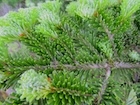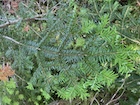Abies mariesii
Masters 1879
Common names
オオシラビソ Ōshirabiso, or アオモリトドマツ Aomoritodomatsu [Japanese], Maries fir.
Taxonomic notes
One of two species in Abies sect. Amabilis. Type: Japan, Honshu, Awomori Prefecture, Nikko-san, C. Maries 73 (holo K); the collection was on Hakkoda Mountain in 1878. Syn.: Pinus mariesii (Mast.) Voss 1907; Abies mariesii Mast. f. hayachinensis Hayata1955 (Farjon 1998).
Description
Trees to 30 m tall and 100 cm dbh, with a broad-pyramidal crown of long, spreading, later downcurved branches. Bark first smooth and pale gray, with age darkening and becoming rough, scaly. Twigs slender, light brown, ridged and grooved, dense brown-pubescent, becoming glabrous and gray with age. Buds globose, resinous, 2-3 mm long, covered by apical leaves; scales brown, ciliate, persisting 2-3 years. Leaves spirally arranged, pectinate on shade foliage, on sun foliage shorter, more nearly erect, curved inwards and forwards to cover the shoot; (6-)10-20(-25) × 1.6-2.5 mm, widest near the emarginate or obtuse apex, linear, strongly twisted and narrowed at base, flattened, dark green and grooved above with slightly revolute margins, paler green below with 2 white stomatal bands and a green midrib. No stomata on upper surface. Pollen cones lateral, axillary, pendulous, 15-20 mm long, yellowish when fertile. Seed cones lateral, nearly sessile, often densely clustered on branches in the upper crown, ovoid-oblong, 4-9 × 2-4.5 cm, violet-blue maturing dark blackish-purple, with a persistent narrowly conical dark brown rachis. Seed scales at mid-cone 15-22 × 20-25 mm, smooth, puberulent, upper margin entire and incurved; bracts obovate, 10-15 mm long, not exserted. Seeds conical-ovoid, 5-7 mm long, light brown with a 10-12 mm light brown cuneate wing (Farjon 2010).
Distribution and Ecology
Japan: Honshu, in mountains from Nagoya north to Aomori at elevations of (750-)1000-2800 m, mostly on podzolic soils derived from volcanic rock; climate is cool and summer-wet, ca. 2000 mm annual precipitation. Typhoons are the principal disturbance. Near the alpine timberline A. mariesii may form pure stands (photo at right), but it mainly occurs in montane to subalpine mixed conifer forests with, e.g., Abies veitchii, Picea jezoensis var. hondoensis, Tsuga diversifolia, and on exposed sites such as ridgetops Juniperus communis var. nipponica and Pinus pumila. Common angiosperm trees include Betula ermanii, Sorbus commixta, and Acer spp. Shrub bamboo (Sasa paniculata and S. nipponica) is locally common in the understory. See A. veitchii for remarks on the competitive relationship between the sympatric A. mariesii and A. veitchii, and on the species' occurrence in fir wave forests.
Hardy to Zone 6 (cold hardiness limit between -23.2°C and -17.8°C) (Bannister and Neuner 2001).
Remarkable Specimens
No data as of 2023.02.22.
Ethnobotany
No data on use by aboriginal peoples. In modern times A. mariesii is not used for timber production because the wood is of little value and the species grows in relatively inaccessible locations. It is also uncommon in horticulture, mostly seen in larger botanical gardens and arboreta in areas with a suitable climate (Farjon 2010).
Observations
No data as of 2023.02.22.
Remarks
The epithet honors the collector, English botanist Charles Maries, who introduced over 500 east Asian species to European horticulture.
Citations
Masters. 1879. Gardener's Chronicle ser. 2, 12:788. Available: Biodiversity Heritage Library, accessed 2023.11.29.
See also
Elwes and Henry 1906-1913 at the Biodiversity Heritage Library. This series of volumes, privately printed, provides some of the most engaging descriptions of conifers ever published. Although they only treat species cultivated in the U.K. and Ireland, and the taxonomy is a bit dated, still these accounts are thorough, treating such topics as species description, range, varieties, exceptionally old or tall specimens, remarkable trees, and cultivation. Despite being over a century old, they are generally accurate, and are illustrated with some remarkable photographs and lithographs.
Farjon, Aljos. 1990. Pinaceae: drawings and descriptions of the genera Abies, Cedrus, Pseudolarix, Keteleeria, Nothotsuga, Tsuga, Cathaya, Pseudotsuga, Larix and Picea. Königstein: Koeltz Scientific Books.
- Provides a detailed account, with illustrations.
Farjon (2010).
Iwatsuki et al. (1995).





